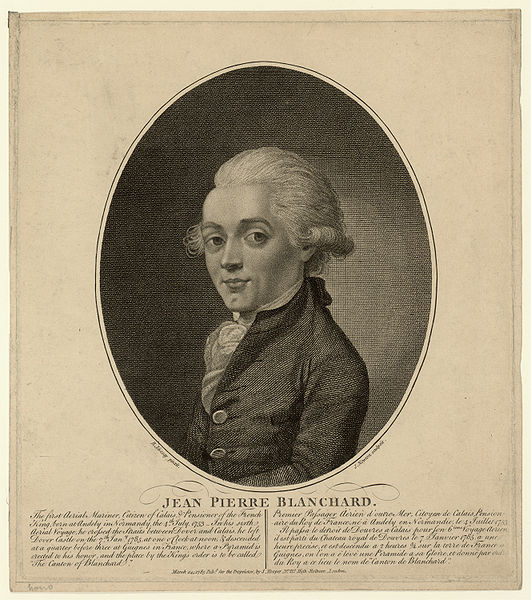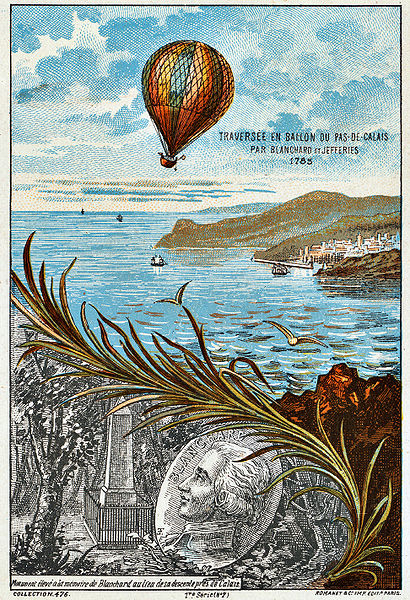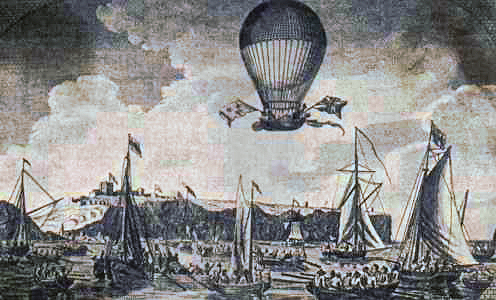<Back to Index>
- Aviation Pioneer Jean Pierre Blanchard, 1753
- Songwriter Sthephen Collins Foster, 1826
- 30th President of the United States John Calvin Coolidge, Jr., 1872
PAGE SPONSOR


Jean-Pierre Blanchard (July 4, 1753 – March 7, 1809), aka Jean Pierre François Blanchard, was a French inventor, most remembered as a pioneer in aviation and ballooning.
Blanchard made his first successful balloon flight in Paris on 2 March 1784, in a hydrogen gas balloon launched from the Champ de Mars. The first successful manned balloon flight had taken place on 21 November 1783, when Pilâtre de Rozier and the Marquis d'Arlandes took off at the Palace of Versailles in a tethered hot air balloon constructed by the Montgolfier brothers. The first manned hydrogen balloon flight had taken place on December 1, 1783, when Professor Jacques Charles and Nicolas-Louis Robert launched La Charlière from the Jardin des Tuileries in Paris. Blanchard's flight nearly ended in disaster, when one spectator - Dupont de Chambon, a contemporary of Napoleon at the École militaire de Brienne - slashed at the balloon's mooring ropes and oars with his sword after being refused a place on board. Blanchard intended to "row" northeast to La Villette but the balloon was pushed by the wind across the Seine to Billancourt and back again, landing in the rue de Sèvres. Blanchard adopted the Latin tag Sic itur ad astra as his motto.
The early balloon flights triggered a phase of public "balloonmania", with all manner of objects decorated with images of balloons or styled au ballon, from ceramics to fans and hats. Clothing au ballon was produced with exaggerated puffed sleeves and rounded skirts, or with printed images of balloons. Hair was coiffed à la montgolfier, au globe volant, au demi-ballon, or à la Blanchard.
Blanchard moved to London in August 1784, where he took part in a flight on 16 October 1784 with John Sheldon, just a few weeks after the first flight in Britain (and the first outside France), when Italian Vincenzo Lunardi flew from Moorfields to Ware on 15 September 1784. Blanchard's propulsion mechanisms - flapping wings and a windmill - again proved ineffective, but the balloon flew some 115 km from the military academy in Chelsea, landing in Sunbury and then taking off again to end in Romsey. Blanchard took a second flight on 30 November 1784, taking off with an American, Dr John Jeffries, from Rhedarium Garden west of Grosvenor Square in London to Ingress in Kent. A third flight, again with Jeffries, was the first flight over the English Channel, taking about 2½ hours to travel from England to France on 7 January 1785, flying from Dover Castle to Guînes. Blanchard was awarded a substantial pension by Louis XVI. (A subsequent Channel crossing attempt in the opposite direction by Pilâtre de Rozier on 15 June 1785 ended unsuccessfully in a fatal crash.)
Blanchard toured Europe, demonstrating his balloons. Blanchard holds the record of first balloon flights in Belgium, Germany, the Netherlands, and Poland. Among the events that included demonstrations of his abilities as a balloonist was the coronation of Holy Roman Emperor Leopold II as king of Bohemia in Prague in September 1791.
Following the invention of the modern parachute in 1783 by Sébastien Lenorm and in France, in 1785 Jean-Pierre Blanchard demonstrated it as a means of safely disembarking from a hot air balloon. While Blanchard's first parachute demonstrations were conducted with a dog as the passenger, he later had the opportunity to try it himself when in 1793 his hot air balloon ruptured and he used a parachute to escape. Subsequent development of the parachute focused on it becoming more compact. While the early parachutes were made of linen stretched over a wooden frame, in the late 1790s, Blanchard began making parachutes from folded silk, taking advantage of silk's strength and light weight.
On 9 January 1793, Blanchard conducted the first balloon flight in North America, ascending from Philadelphia, Pennsylvania, and landing in Deptford, Gloucester County, New Jersey. One of the flight's witnesses that day was President George Washington, and the future presidents John Adams, Thomas Jefferson, James Madison, and James Monroe. Blanchard left the United States in 1797.
He married Marie Madeleine-Sophie Armant (better known as Sophie Blanchard) in 1804. In 1809, Blanchard had a heart attack while in his balloon at the Hague. He fell from his balloon and died some weeks later from his severe injuries. His widow continued to support herself with ballooning demonstrations until it also killed her. On 6 July 1819, Norwich Duff, an Edinburgh born naval officer then undertaking a tour of western Europe, recorded in his travel log how he:
| “ | went to a Grand Fete at the Tivoli Gardens (Jardin de Tivoli, Paris) where [he] witnessed a most melancholy accident: among other amusements for the evening Madame Blanchard was to ascend from the garden in a Balloon, and when a certain height in the air, to set off a display of fire works; owing to the Balloon touching some trees as it ascended, from the people not allowing it to rise at once, a part of the fire works were deranged, and on their being let off, threw their fire upwards in place of downwards, set fire to the Balloon, [which] burst, and precipitated poor Madame Blanchard with her car, from the height of several thousand feet, into the Rue Provence, where she fell on top of a house and from there into the street where she was dashed to pieces. The effect of so shocking an accident on the minds of several thousand people assembled for amusement, and in high spirits, may easily be imagined: everything else was put a stop to, the proprietors gave notice that the admission money would be given to the poor woman's children, and ladies and gentlemen stood at the gate to receive subscriptions for her family'. | ” |
